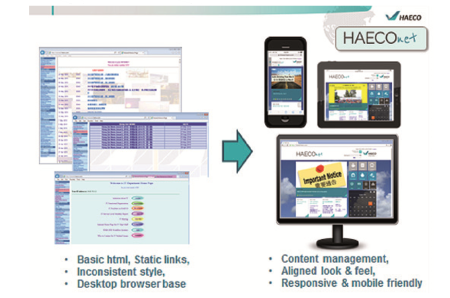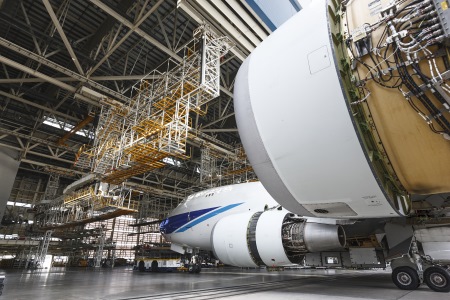Articles
| Name | Author | |
|---|---|---|
| Case Study: MRO Software Implementation Case Study at Aircraft Maintenance Services Australia (AMSA) | Clanci Ferguson, Business Development Leader, Aircraft Maintenance Services Australia, and Gerry Croarkin, Business Development Director, Rusada | View article |
| HAECO’s journey to Mobility | Louis Wong, Enterprise Architecture Manager, HAECO | View article |
| Column: How I see IT – Go paperless: write that down! | Paul Saunders, Solution Manager, Flatirons Solutions | View article |
| Look – no hands! Voice Control for MRO | Jeff Pike, Head of Strategy and Marketing, IFS Aerospace and Defense Center of Excellence | View article |
| Paperless Maintenance: The shape of things to come | Paul Saunders, Global Product Manager, Flatirons Solutions | View article |
HAECO’s journey to Mobility
Author: Louis Wong, Enterprise Architecture Manager, HAECO
SubscribeLouis Wong, Enterprise Architecture Manager at HAECO explains HAECO’s journey to a paperless workplace and Business Intelligence

A lot is spoken these days about the paperless workplace but my own view is that ‘paperless’ is more a side product resulting from projects on mobility as well as business intelligence. So this article won’t dwell too much on the ‘paperless’ result but will rather share with readers our experience at HAECO on mobility and business intelligence projects… starting with mobility.
MOBILITY
Mobility is a key component in HAECO’s IT strategy for a very simple reason; in Hong Kong, where the company is based, the mobile phone penetration rate is really high, possibly the highest in the world. With a population of about seven million and some 17 million mobile devices, that gives us a average of two to three devices per person. Looking more specifically at our work environment at HAECO, most front-line staff are field workers, with no fixed location and no access to a computer so it’s difficult to get information to them. However, it is more than likely that they’ll have their own mobile phone. So we have treated this program as an opportunity to deliver information to them through their mobile phone instead of giving them a computer. It has a great potential to deliver considerable benefits in terms of communicating information and improving productivity. The HAECO’s mobility program started in 2014 and there are three different projects involved – the Line Services Mobility; the HAECOnet; and the Light Maintenance Mobility
Line Services Mobility
The objective of Line Services Mobility project is very simple; we want to deliver information to HAECO’s line services staff on to their own BYOD (bring your own device) mobile phones – iOS and Android. The scope of information for phase one includes flight schedules and information for ‘meet and greet’, flight status updates, job allocation , task required, aircraft defect alerts, spares status, etc. We have a future plan to put more functionality into the apps so the staff can directly update task related information; for example, simple work status updates which will enable them to complete a task on the spot. The ultimate goal is to provide line services staff with all the information required to avoid the need to carry paper or to have to travel back to the base. That should improve engineers’ productivity for faster turnaround times and improved service for customers.
Challenges to the mobility program
Like any IT project, the program involves a business process change which can generate a lot of resistance. Front line people are now asked to use their mobile phones, instead of using paperwork with which they have become familiar over the last 10-15 years. It requires a lot of lobbying and communications with opinion leaders to ensure that the final solution will suit the needs of the end users. Another challenge is to get the right level of usability for the Apps. We are all so spoilt by the Internet and today’s smart phones that, any mobile phone application, even for the workplace, has to be intuitive and user friendly; otherwise nobody will use it. Unfortunately, application usability is an area where IT practitioners are often weak. So, for this part of the program, HAECO engaged external experts to help.
We also spent a lot of time thinking about how to handle staff communication, direct them to download the app; help them to understand the app; and how we could distribute the accounts and passwords. We were aware that the target group is people who had not used a computer at work in the past, so there was no userid/password assigned to them. It created a logistics issue for HAECO because we had to create many user accounts for the first time, as well as designing the supplementary functionalities such as ‘password reset’ and ‘change password’, and the process for new joiners and leavers. Designing this whole process took a lot of time but is essential, both for this and future projects. Supporting the Apps on both iOS and Android platforms was relatively simple in comparison.
How the Mobility App works
The App shows each user, after login, a landing page that will display the three most crucial pieces of information they will need… what are their assignments; what tools are needed or outstanding, and are there any particular issues that need to be addressed immediately.
%20AssignmentsSm.png)
%20WeatherSm.png)
%20ContactsSm.png)
More functionality is in the ‘flight schedule’ page, which presents which flights are coming in and which are going out. There are multiple filters that can base on inbound/outbound, user’s priority list, or time of the day. The flight list presents other information as well, for instance, an icon with ice and a cross indicates that the incoming aircraft has an issue with its air conditioning. With this, the engineer can have a good idea about the incoming aircraft, and is there anything that needs to be prepared before he works on this plane? There is also information about whether the flight is delayed or on time. Clicking on the flight will bring up details such as flight number, and the planned task cards for this aircraft. We also packaged other information into the Apps including contact lists and other general alert messages.
INTRANET
The HAECO Intranet has been in service for more than 15 years using static html technology, a revamp has long been overdue. In this project, we give it a responsive design for better compatibility with mobile phones. The key objective of the project is to enhance staff communication and engagement. Compatibility with the mobile phone is important as we want to get in touch with the staff through a channel they prefer. We also wanted a sound platform on which to develop future functionalities.

In the image above, the screenshots on the left represent HAECO’s current Intranet that has been in use for more than ten years. It is, as can be seen, very basic using html and static links with inconsistent styles across different screens. It was also difficult to manage and update the information on different pages. Contributing departments had to prepare the information and send to IT, who then performed the coding and other tasks before the information could be published.
On the right of the image is what HAECO’s new Intranet looks like. It’s a content management based application where the look & feel of the site are managed through the use of templates. The templates are centrally managed by the IT for consistency; but content creation and updating can be decentralized back to individual departments. It’s a responsive design that can cater for different device environments including desktop, tablet and mobile phone.
Challenges to the Intranet project
The main challenge, again, is the mindset change of the people who have to use the system. Through multiple roadshows and campaigns, we explained the future plan in staff communications and the role of the revamped Intranet. Similar to the Line Services Mobility project, many staff were previously not IT users and have no user accounts, so we also had to create the login accounts for them as well as the various supplementary features.
The Intranet now and our future plans
We packaged the two projects (Mobility and Intranet) together so that we could have a consistent username pattern, a consistent arrangement of login IDs with all the processes necessary to support them. All along, our objective has been to design a system that has good usability, is intuitive and can cope with different levels of IT skills within the business.

One interesting idea is what we call ‘content fitting’. We wanted to ensure that the mobile phone would be our key channel; but a message too long or too clumsy will just turn people away. So we have decided that for any content to be put onto the Intranet, there need to be two versions; a full version for viewing on a PC or tablet, as well as a mobile version more suited to the mobile phone environment, essentially a précised summary of the content with a link back to the full version. That allows staff to gain a quick overview of the message with flexibility to read the full document if necessary.
We plan to move more staff communications and staff related functionality onto the Intranet. This is really a platform to engage the staff; give them what they want to understand for their personal benefit; such as information about their career in the company, promotion opportunities, salary and employment benefits. While the mobile apps are for the staff to carry out their work, the Intranet is for them to understand what they can get from the company.
Looking ahead, we would like to get more functionality onto this platform to engage the staff bi-directionally: to encourage them to give feedback, ideas for improvement and what they’d like the company to provide for them in the future.
LIGHT MAINTENANCE MOBILITY
This project is an application that will be run on the iPad and is targeted for light maintenance projects which usually have a 24 hours or less duration. Turnaround time is crucial for these projects and we need to get as much preparation as possible completed before aircraft arrival. Currently, the preparation involves much paperwork and task cards which consume precious time for engineers and supervisors, and are non-productive as compared to conducting supervision and quality assurance on the aircraft itself. The plan is to issue tablets that will provide all the information previously delivered on paper so that they search the information more efficiently, without the need to flip through all the cards for the paperwork.
The project has two parts. One is the mobile electronic task card (Mobile Mechanics), a packaged solution that HAECO acquired from our MRO solution vendor. To be deployed on iPads, this will help engineers to:
• Perform engineering services (On-Task);
• Search tor the right Task Card;
• Conduct post-task data entry.
A second part of the project is to get the required maintenance manuals onto the iPads. The HAECO in-house Business Improvement team identified time wastages in the maintenance process which are the results of paper-based tasks, providing access to manuals from an tablet device will help us to tackle a number of these wastages.
Benefits from the Line Maintenance Mobility
Obviously, the key tangible benefit is that the time saved from different ’wastages‘ could now be redeployed to productive tasks, but an equally important one is that data can be fed back into the system to better estimate resource requirements for future projects and support better resource planning which, in turn, also promotes better on-time delivery.
There are also intangible benefits we envisaged. The paperless result will definitely be a help to our environment: in the past, we would print something like 700 to 1,000 pages per project which also need post-project storage; with an electronic-based application there is no need to consume, print or store paper.
Challenges to the Line Maintenance Mobility project
There were, of course, challenges for the project as well as the process changes.
For one, we had to get through to the regulator and gain approval from the Hong Kong Civil Aviation Department (CAD). There had been a number of meetings to reassure that:
• The IT solution is robust and secure;
• The electronic records are legitimate and prudent;
• Records and signatures are trackable.
For this we relied on the experience of the product vendor who could leverage prior experience gained in dealing with the FAA.
Besides task specific documentation, getting maintenance manuals onto the mobile devices is also a big challenge. Although we limited the scope of the project to focus on Light Maintenance, there are still different manuals from customers and OEMs, which requires us to access websites in different versions (OS version, browser version, Java version…) and this variety is complicated and difficult. We had leveraged two key technologies to solve this puzzle: the Microsoft Terminal Server technology will centrally manage the configurations required for all of the different web environments; and the VDI (virtual desktop infrastructure) technology to package all these terminal access and deploy onto the iPad.
This basic approach sounds simple, but the multiplicity of technologies is still a big challenge – tablets to use VDI technology plus terminal servers running different browsers with different plugins, the result in terms of compatibility and usability is quite unknown.
BUSINESS INTELLIGENCE (BI)
The BI project was set out in 2014. Historically HAECO has been a paper-based company with information held in different places around the organization. We have a home-grown ERP (Enterprise Resource Planning) system called ECHO where operational data is stored; Finance data is kept in a separate system, plus there are a number of end user data files like excel spreadsheets, etc. Creating reports from these data is mostly a manual process, both time consuming and requiring a long lead time. By the time reports are prepared and delivered, they are often outdated, and occasionally there are data integrity issues.
In this project we were working to establish a BI platform that can be extensible for corporate use, provide advance analytics through consolidating data from different sources, and enable self-service, interactive and visualized analysis. We have already completed phase one of the project; phase two is now drawing to a close, and we are planning for phase three in 2016.
In phase one, we focused on two business dashboards: inventory control for Material Management and a Finance dashboard for finance, which is also accessible by the contributing departments. Phase one of the project lasted for around five months and was a great success. Not only that, the reports are now automated and timely, calculations are now consistent, and end user data are reduced and kept under control, while business metrics are aligned; but the biggest benefit is that business data are now available and visualized to the business, which enables users to perform analysis and react much quicker.
In phase two we are expanding the scope of the BI solution to include more departments:
• Airframe Services: where they’ll look at metrics such as hangar utilization and productivity;
• Procurement: where they’ll be able to monitor spend analysis, supplier performance and more;
• Human Resources: where they’ll be able to monitor staff attrition rates, staff movement and other staff information;
• Material Planning: where we plan to forecast material demand based on hangar input as well as historical data.
Challenges to the Business Intelligence program
The challenges from the BI program are somewhat different than those faced by the mobility program. Business departments’ readiness and maturity in data analysis is a key one. While some departments have better understanding of how a BI platform can help, some are less mature.
Data cleansing was another challenge which took a long time. We had to uncover where the data was currently held and work out the best way to get it out. Many data sit in Excel spreadsheets with Macros around them, understanding the data transformation rules from the embedded logic was a tedious task.
Finally, we realized that, although there are terms commonly used across the company, different people may use those terms with different meanings. So we had to undertake a data definition exercise and establish governance control. For example, the term ‘productivity’ may have different meaning when referring to an engineer than with a team of cleaners, and we have to make it explicit and clear which context we are referring to in when used in the BI platform.
Notwithstanding all of the above, we see Mobility and Business Intelligence as a journey on which we are just starting out at HAECO. There will be more of these projects in the future.
Contributor’s Details
 Louis Wong
Louis Wong
Louis Wong is an experienced IT practitioner who is knowledgeable and skilled in solution delivery, architecture, infrastructure, and project management. He has over 25 years’ solid experience in various airline businesses and operations domains, supporting strategic objectives in global environments. Louis joined HAECO in 2014 where he is IT Manager, Enterprise Architecture, responsible for setting technology direction, architecture governance and group level alignment. He also has responsibility in ensuring information security in the organization.
 HAECO
HAECO
HAECO is an independent aircraft engineering and maintenance group and one of the largest Maintenance, Repair and Overhaul (MRO) service providers in terms of capacity. Through 19 subsidiaries and joint venture companies around the world, the Group offers a full spectrum of services including airframe services, line services, component services, engine services, inventory technical management, fleet technical management, cabin integration services and interior products, private jet solutions, freighter conversion, parts manufacturing and technical training.
Comments (0)
There are currently no comments about this article.

To post a comment, please login or subscribe.